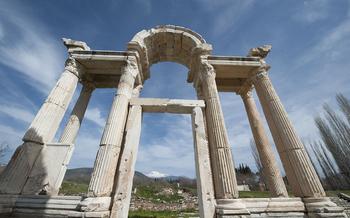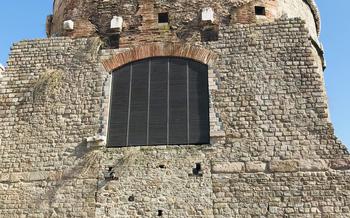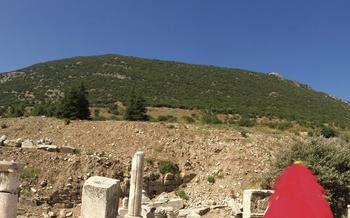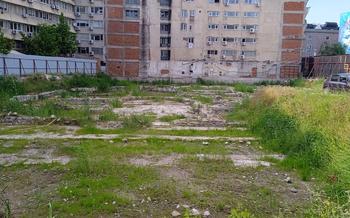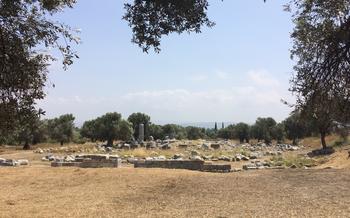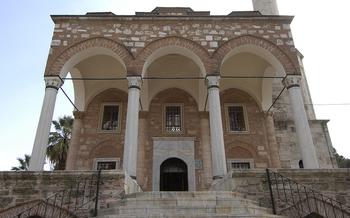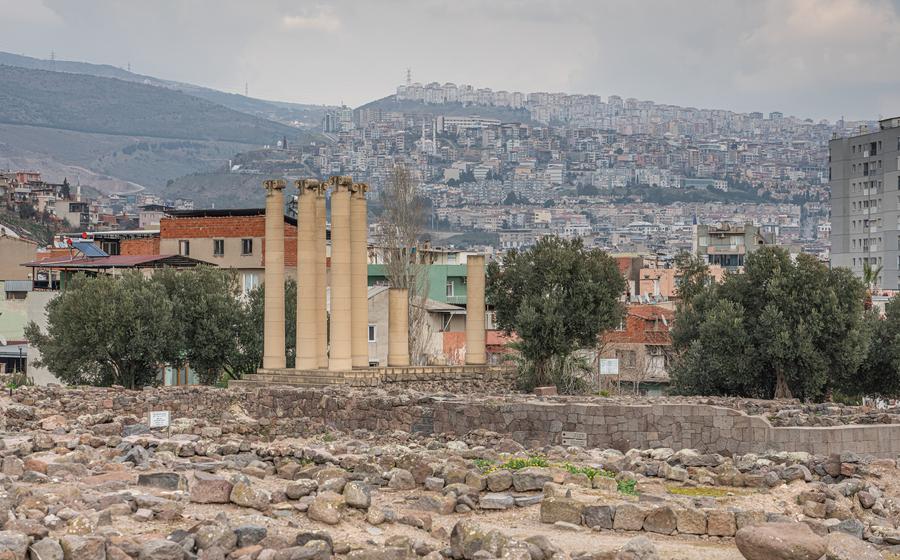
Smyrna Ruins
- Unveiling the Ancient Wonder: A Journey to Smyrna Ruins
- Strolling the Agora, the Heart of Ancient Smyrna
- Exploring the Theater, Where Drama Unfolded
- Architectural Elements and Seating Arrangements
- Acoustics and Stage Design
- Performances and Significance in Ancient Society
- Unveiling the Gymnasium, a Place of Health and Training
- Admiring the Nymphaeum, a Sanctuary to Water Nymphs
- Significance of Water in Ancient Greek Mythology
- Architectural Features and Decorative Elements
- Water Channeling Systems and Fountains
- Religious and Cultural Significance
- Roman Baths: A Sanctuary of Relaxation and Hygiene
- Visiting the Archaeological Museum of İzmir, a Treasure Trove of Discoveries
- Taking a Guided Tour, Unveiling Hidden Gems
- Capturing the Essence: Photography Tips for Memorable Shots
- Planning Your Visit: Essential Information for a Smooth Journey
- Respecting the Past: Etiquette and Conservation Guidelines
- Combining History with Nature: Nearby Attractions
- Insider Tip: Unveiling the Hidden Treasure
Unveiling the Ancient Wonder: A Journey to Smyrna Ruins
Step into a realm where history and myth intertwine, where the remnants of a glorious past whisper tales of ancient civilizations. Embark on a journey to the Smyrna Ruins, an archaeological treasure trove nestled in the heart of modern-day İzmir, Turkey.
The Smyrna Ruins stand as a testament to the city's rich cultural heritage, dating back to the 11th century BC when it was founded by Greek colonists. Over the centuries, Smyrna flourished as a major port city and cultural center, attracting diverse influences from Greek, Roman, Byzantine, and Ottoman civilizations.
Archaeological excavations have unearthed a wealth of artifacts and architectural wonders, shedding light on the city's vibrant past. Highlights include the Agora, the Theater, the Gymnasium, the Nymphaeum, the Stadium, the Roman Baths, and the Necropolis.
As you wander through the ruins, feel the weight of history beneath your feet. Imagine the bustling streets filled with ancient traders, philosophers, and artists. Let the stones transport you back in time, to an era where gods and goddesses were revered, and where the human spirit soared in pursuit of knowledge, art, and athleticism.
Strolling the Agora, the Heart of Ancient Smyrna
The agora, a bustling hub of activity in ancient Greek cities, served as the center of commerce, politics, and social gatherings. In Smyrna, the agora was a spacious rectangular plaza situated at the heart of the city. Its strategic location facilitated easy access from various parts of Smyrna, allowing residents and visitors to converge in this vibrant marketplace.
The agora's architectural features showcased the grandeur of ancient Greek design. Colonnaded porticoes lined the perimeter, providing shade and shelter for merchants and shoppers. Within the agora, various structures served specific purposes. Shops and stalls lined the periphery, offering a diverse array of goods, from fresh produce and textiles to pottery and jewelry.
Among the notable structures within the agora was the bouleuterion, the council chamber where the city's governing body, the boule, convened to discuss and make decisions on matters of governance. The bouleuterion's impressive facade and intricate carvings reflected the importance of this civic institution.
Excavations within the agora have unearthed a wealth of artifacts that provide valuable insights into the daily life and culture of ancient Smyrna. Coins, pottery shards, and tools shed light on economic activities and trade. Statues and inscriptions pay homage to deities, commemorate notable citizens, and document historical events.
Strolling through the agora today, visitors can still sense the vibrant energy that emanated from this central gathering place. The architectural remnants, coupled with the unearthed artifacts, offer a tangible connection to the bustling life that once characterized this ancient marketplace.
Exploring the Theater, Where Drama Unfolded
The theater, a quintessential feature of ancient Greek cities, served as a crucial venue for artistic expression, entertainment, and civic gatherings. The Smyrna Theater, with its impressive dimensions and architectural prowess, stands as a testament to the city's cultural significance. Constructed in the 2nd century BC, this magnificent structure could accommodate up to 20,000 spectators, making it one of the largest theaters in the ancient world.
Architectural Elements and Seating Arrangements
The theater's design exemplifies the ingenuity of ancient Greek architects. The vast cavea, or seating area, is divided into three sections: the ima cavea, the media cavea, and the summa cavea. These sections were further subdivided into wedge-shaped blocks known as kerkides, separated by staircases called diazomata. The front rows, reserved for prominent citizens, featured individual stone seats, while the upper sections consisted of wooden benches.
Acoustics and Stage Design
The Smyrna Theater's remarkable acoustics allowed performers' voices to carry throughout the vast auditorium, ensuring that even those seated in the furthest rows could hear clearly. This acoustic marvel was achieved through careful consideration of the theater's shape, dimensions, and materials. The stage, or skene, provided a versatile platform for theatrical performances, with a backdrop of elaborate painted panels depicting scenes from mythology or history.
Performances and Significance in Ancient Society
The theater was not merely a place of entertainment; it played a vital role in ancient Greek society. Dramatic performances, often centered around mythological themes, served as a means of moral education and cultural expression. Tragedies, comedies, and satyr plays were staged, offering audiences a range of emotions and perspectives. The theater also hosted civic assemblies, religious festivals, and musical competitions, fostering a sense of community and civic pride.
Unveiling the Gymnasium, a Place of Health and Training
Physical Fitness in Ancient Greece In ancient Greece, physical fitness and athleticism were highly valued. The gymnasium served as a central hub for individuals to cultivate their physical prowess and prepare for various athletic competitions. These facilities were not only places of physical training but also held significant social and cultural importance, fostering camaraderie and a sense of community among its members.
Design and Layout The gymnasium typically comprised several structures and facilities designed to cater to different athletic activities. The palaestra, a large open space, was utilized for wrestling, boxing, and other forms of combat sports. The ephebeum, a dedicated space for young men undergoing military training, featured facilities for javelin throwing, archery, and other martial exercises. Additionally, there were running tracks, jumping pits, and weightlifting areas, allowing individuals to engage in a comprehensive range of physical activities.
Mosaics and Athleticism The gymnasium was often adorned with mosaics depicting various athletic scenes and mythological figures associated with sports. These intricate artworks not only served as decorative elements but also reinforced the importance of physical fitness and the pursuit of athletic excellence. The mosaics showcased the grace, strength, and agility of athletes engaged in different sports, inspiring visitors to strive for similar achievements.
Promoting Health and Well-being Beyond physical training, the gymnasium also played a crucial role in promoting overall health and well-being. The Greeks believed in a holistic approach to health, emphasizing the balance between physical and mental well-being. The gymnasium provided a space for individuals to engage in activities that not only strengthened their bodies but also invigorated their minds and spirits, fostering a sense of harmony and vitality.
Admiring the Nymphaeum, a Sanctuary to Water Nymphs
Amidst the ruins of Smyrna, discover the Nymphaeum, a sanctuary dedicated to the water nymphs who were revered in ancient Greek mythology as guardians of springs, rivers, and fountains. This sacred site served as a place of worship and a gathering place for the community to honor these deities and seek their blessings.
Significance of Water in Ancient Greek Mythology
Water held immense significance in ancient Greek culture, symbolizing purity, fertility, and life. The nymphs were believed to possess healing powers and the ability to bestow fertility on crops and livestock. Worshipping them was considered essential for ensuring a bountiful harvest and the well-being of the community.
Architectural Features and Decorative Elements
The Nymphaeum of Smyrna showcases remarkable architectural features that reflect the reverence for water and nature. The sanctuary is adorned with intricate carvings and sculptures depicting nymphs, aquatic creatures, and scenes of nature. Water channels and fountains were carefully designed to create a soothing and harmonious ambiance within the sacred space.
Water Channeling Systems and Fountains
The Nymphaeum's water channeling systems were a marvel of ancient engineering. Water was directed from natural springs or aqueducts into the sanctuary, creating a network of fountains and pools. The sound of flowing water added to the serene atmosphere, invoking a sense of tranquility and connection with the natural world.
Religious and Cultural Significance
The Nymphaeum served not only as a place of religious worship but also as a gathering place for social and cultural activities. People would come to the sanctuary to pray, make offerings, and celebrate festivals honoring the water nymphs. These gatherings fostered a sense of community and strengthened the bond between the people and their deities.
Roman Baths: A Sanctuary of Relaxation and Hygiene
In the heart of the Smyrna Ruins, uncover the well-preserved remains of the Roman Baths, a testament to the advanced bathing culture of ancient times. These elaborate structures were not merely places of ablution but also served as social and cultural hubs. Step into the frigidarium, the frigid chamber, where bathers would begin their ritual with a refreshing plunge into cold water. Proceed to the tepidarium, the warm chamber, where the temperature gradually increased, preparing the body for the intense heat of the caldarium, the hot chamber.
Marvel at the intricate heating systems that circulated hot air beneath the floors and within the walls, ensuring a comfortable and therapeutic bathing experience. Admire the architectural finesse of the vaulted ceilings, supported by sturdy pillars, and the elegant mosaic floors adorned with intricate designs depicting scenes of mythology and nature. Imagine the lively atmosphere as ancient Smyrnians gathered here to socialize, gossip, and rejuvenate their bodies and minds. The Roman Baths stand as a remarkable testament to the ingenuity and dedication of the ancient Romans to the pursuit of health, hygiene, and social well-being.
Visiting the Archaeological Museum of İzmir, a Treasure Trove of Discoveries
The Archaeological Museum of İzmir stands as a testament to the rich history and cultural heritage of ancient Smyrna. This treasure trove of discoveries houses a vast collection of artifacts unearthed from the Smyrna Ruins, offering visitors a glimpse into the city's glorious past.
The museum's exhibits are organized chronologically, guiding visitors through the various periods of Smyrna's history, from its humble beginnings to its rise as a prominent city in the ancient world. Thematic galleries showcase artifacts related to specific aspects of life in ancient Smyrna, such as religion, trade, and daily life.
Among the highlights of the museum's collection are exquisite sculptures, intricate pottery, and jewelry that provide insights into the artistic prowess of the Smyrnians. Visitors can admire the delicate craftsmanship of marble statues, the vibrant colors of painted pottery, and the intricate designs of gold and silver jewelry.
Interactive displays and educational programs enhance the museum experience, allowing visitors to engage with the artifacts and gain a deeper understanding of ancient Smyrna's culture and history. The museum's knowledgeable staff is always ready to assist visitors, providing insights and answering questions.
A visit to the Archaeological Museum of İzmir is a must for anyone interested in exploring the rich history of ancient Smyrna. The museum's collection offers a tangible connection to the past, bringing the stories of this ancient city to life.
Taking a Guided Tour, Unveiling Hidden Gems
Unveiling the secrets of the Smyrna Ruins requires an immersive experience that delves into the intricacies of this ancient city. Guided tours offer an unparalleled opportunity to discover hidden gems, uncover forgotten stories, and gain a deeper understanding of Smyrna's rich history.
Led by knowledgeable and passionate guides, these tours provide expert insights into the archaeological discoveries, architectural marvels, and cultural significance of the ruins. With their captivating storytelling and historical anecdotes, guides bring the past to life, painting a vivid picture of Smyrna's vibrant streets, bustling markets, and grand spectacles.
Tailor-made itineraries cater to diverse interests, whether you're an architecture enthusiast, a history buff, or simply curious about ancient civilizations. From exploring the theater's acoustics to uncovering the secrets of the necropolis, guided tours offer a personalized journey that unveils the hidden layers of this remarkable site.
Embrace the opportunity to delve into the depths of Smyrna's past with a guided tour. Let the experts lead you on an unforgettable journey through time, where history comes alive and the essence of this ancient city is revealed.
Capturing the Essence: Photography Tips for Memorable Shots
Golden Hour Magic: Plan your visit to the Smyrna Ruins during the golden hours of sunrise or sunset. The soft, warm light beautifully illuminates the ancient stones, creating a magical ambiance that will elevate your photographs.
Architectural Details: Capture the intricate details of the ruins, such as the columns, friezes, and carvings. Get close, experiment with different angles, and use a wide-angle lens to showcase the grandeur of these architectural masterpieces.
Panoramic Views: Step back and take in the breathtaking panoramic views of the Smyrna Ruins. Use a tripod to ensure stability, and capture the vastness of the site, the surrounding landscape, and the distant sea.
Storytelling Through Images: Approach photography as a form of storytelling. Look for elements that convey the essence of the ruins—a lone column standing defiantly against the sky, a worn inscription hinting at ancient lives, or a mosaic tile revealing a glimpse of the past.
Recommended Settings: Use a low ISO to minimize noise, a wide aperture to blur the background and highlight your subject, and a shutter speed that allows you to capture sharp images without motion blur.
Essential Equipment: Bring a sturdy tripod to stabilize your camera, especially for long exposure shots. A wide-angle lens will help you capture expansive views, while a telephoto lens will allow you to zoom in on distant details.
Planning Your Visit: Essential Information for a Smooth Journey
Organizing a smooth and enjoyable visit to the Smyrna Ruins requires careful planning and consideration of essential information. Firstly, the ideal time to visit is during the shoulder seasons, spring (April-May) and autumn (September-October), when the weather is pleasant, and the crowds are smaller. During summer, temperatures can soar, making exploration less comfortable, while winter may bring rain and fewer operational hours.
Once at the site, visitors can find basic facilities such as restrooms, a café, and a souvenir shop. Accessibility options are limited, but wheelchairs can be rented on-site. It's advisable to wear comfortable shoes as the terrain involves uneven surfaces and cobblestone paths. Sun protection, water, and a hat are essential, especially during summer.
To make the most of your visit, consider the following tips: arrive early to avoid crowds, especially during peak tourist season. Allocate at least half a day to explore the ruins thoroughly. If possible, visit on a guided tour, which provides valuable insights and historical context. For independent travelers, audio guides are available for rent.
Finally, remember that the Smyrna Ruins are a protected historical site. Visitors are expected to respect the integrity of the ruins by refraining from touching or climbing on the structures. Photography is generally permitted, but using flash or tripods may be restricted in certain areas. By following these guidelines, you can contribute to the preservation of this ancient wonder for generations to come. So, prepare for an enriching journey through history and culture as you explore the Smyrna Ruins.
Respecting the Past: Etiquette and Conservation Guidelines
As we delve into the ancient wonders of Smyrna Ruins, it is crucial to remember that these relics are not just remnants of the past but also living testaments to our shared cultural heritage. Preserving and respecting them is our collective responsibility, ensuring that future generations can continue to marvel at their splendor.
When visiting archaeological sites, it is essential to adhere to proper etiquette and conservation guidelines. Firstly, refrain from touching or leaning against the ruins, as the oils from our skin can damage the delicate surfaces. Secondly, avoid climbing on the structures, as this can cause structural damage and erosion. Thirdly, refrain from removing any artifacts or souvenirs from the site, as they are protected by law and belong to the collective heritage of humankind.
Furthermore, it is crucial to be mindful of our impact on the environment. Dispose of waste responsibly in designated bins, and avoid littering or leaving any traces of our visit behind. By practicing responsible tourism, we can help protect the integrity of the site and ensure its preservation for future generations.
Finally, consider supporting local conservation efforts and initiatives. These organizations work tirelessly to protect and restore archaeological sites, ensuring their legacy endures. By contributing to their efforts, we become active participants in preserving our shared cultural heritage and ensuring that the Smyrna Ruins continue to captivate and inspire visitors for generations to come.
Combining History with Nature: Nearby Attractions
Beyond the Smyrna Ruins, İzmir offers a wealth of historical and natural wonders waiting to be explored. Mount Sipylus, a majestic mountain range, beckons with its natural beauty and mythological significance. Hike through its lush forests, marvel at the legendary Niobe Weeping Rock, and uncover the secrets of ancient cave dwellings.
Venture to the charming village of Birgi, a hidden gem nestled amidst rolling hills. Wander through its cobbled streets, admire the well-preserved Ottoman architecture, and soak in the tranquil atmosphere. Discover hidden churches and mosques, remnants of a rich cultural heritage.
Unveil the ancient city of Ephesus, a UNESCO World Heritage Site, just a short drive from İzmir. Step into the remarkably preserved ruins of this once-thriving metropolis, and marvel at the grandeur of the Library of Celsus, the Great Theater, and the Temple of Artemis. Immerse yourself in the history of this ancient city, where civilizations intersected and left their indelible mark.
Finally, embrace the vibrant city of İzmir itself, a modern metropolis with a rich history and diverse attractions. Explore the bustling markets, savor the delectable local cuisine, and soak in the vibrant atmosphere of this cosmopolitan city. İzmir's museums, art galleries, and cultural events offer a glimpse into its contemporary culture and heritage.
Insider Tip: Unveiling the Hidden Treasure
Beyond the well-known landmarks of the Smyrna Ruins, there lies a hidden treasure waiting to be discovered. Descend into the depths of the ancient cistern, a subterranean marvel that once stored precious water for the city's inhabitants. Marvel at the intricate engineering that allowed water to flow through underground channels, ensuring a steady supply even in times of drought.
Explore the enigmatic underground tunnels, a secret passageway that once served as a vital connection between different parts of the city. Imagine the footsteps of ancient Smyrnians echoing through these subterranean corridors, their secrets and stories forever etched into the stone walls.
Uncover the hidden mosaics, remnants of ancient artistry that have lain buried beneath the sands of time. These colorful tiles depict scenes from mythology, daily life, and religious rituals, offering a glimpse into the vibrant culture and beliefs of the ancient Smyrnians.
Experience the ruins at sunset, when the fading light casts a magical glow upon the ancient stones. The shadows lengthen, creating an ethereal atmosphere that transports you back in time. Let the tranquility of the evening envelop you as you soak in the beauty of this ancient city, its history whispering secrets in the twilight.
